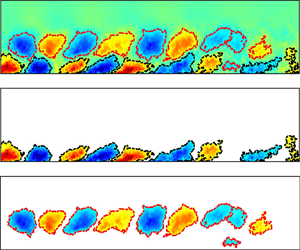Article contents
Statistical signatures of  $u$ component wall-attached eddies in proper orthogonal decomposition modes of a turbulent boundary layer
$u$ component wall-attached eddies in proper orthogonal decomposition modes of a turbulent boundary layer
Published online by Cambridge University Press: 29 June 2022
Abstract

Physical representation of coherent motions in wall-bounded turbulence satisfying Townsend's attached-eddy hypothesis (AEH) is still an open question to be debated. Here, we apply proper orthogonal decomposition (POD) to instantaneous snapshots of  $u$ component velocity fields in the streamwise–wall-normal plane of three turbulent boundary layers, which cover a frictional Reynolds number (
$u$ component velocity fields in the streamwise–wall-normal plane of three turbulent boundary layers, which cover a frictional Reynolds number ( $Re$) of
$Re$) of  $Re_\tau \approx 1000{\sim} 4000$ and were either measured by large-field-of-view planar particle image velocimetry or calculated by direct numerical simulation. The
$Re_\tau \approx 1000{\sim} 4000$ and were either measured by large-field-of-view planar particle image velocimetry or calculated by direct numerical simulation. The  $u$ component POD modes characterized by streamwise recurring large-scale motions are decomposed into wall-attached and wall-detached parts depending on the wall-attachment condition. The former, i.e. wall-attached POD eddies, are believed to be the prime statistical representations of attached eddies. The reason lies in three aspects. Firstly, wall-attached POD eddies are geometrically self-similar and statistically independent. Secondly, the wall-normal variation of the variance of reduced-order streamwise velocity components
$u$ component POD modes characterized by streamwise recurring large-scale motions are decomposed into wall-attached and wall-detached parts depending on the wall-attachment condition. The former, i.e. wall-attached POD eddies, are believed to be the prime statistical representations of attached eddies. The reason lies in three aspects. Firstly, wall-attached POD eddies are geometrically self-similar and statistically independent. Secondly, the wall-normal variation of the variance of reduced-order streamwise velocity components  $\tilde {u}_{AE}$, which is only contributed by wall-attached POD eddies, presents logarithmic decay in the inertial flow region. Thirdly, analysis on the scaling behaviour of the high-even-order moment, moment generating function, as well as longitudinal two-point structure function, all indicate a quasi-Gaussian behaviour of
$\tilde {u}_{AE}$, which is only contributed by wall-attached POD eddies, presents logarithmic decay in the inertial flow region. Thirdly, analysis on the scaling behaviour of the high-even-order moment, moment generating function, as well as longitudinal two-point structure function, all indicate a quasi-Gaussian behaviour of  $\tilde {u}_{AE}$. None of these AEH-predicted behaviours are evident when the contribution of superstructure-like POD eddies are considered. Furthermore, wall-detached POD eddies are found to also present quasi-Gaussian behaviour. They might be treated as passive fragments of wall-attached ones.
$\tilde {u}_{AE}$. None of these AEH-predicted behaviours are evident when the contribution of superstructure-like POD eddies are considered. Furthermore, wall-detached POD eddies are found to also present quasi-Gaussian behaviour. They might be treated as passive fragments of wall-attached ones.
Information
- Type
- JFM Papers
- Information
- Copyright
- © The Author(s), 2022. Published by Cambridge University Press
References
REFERENCES
- 28
- Cited by


